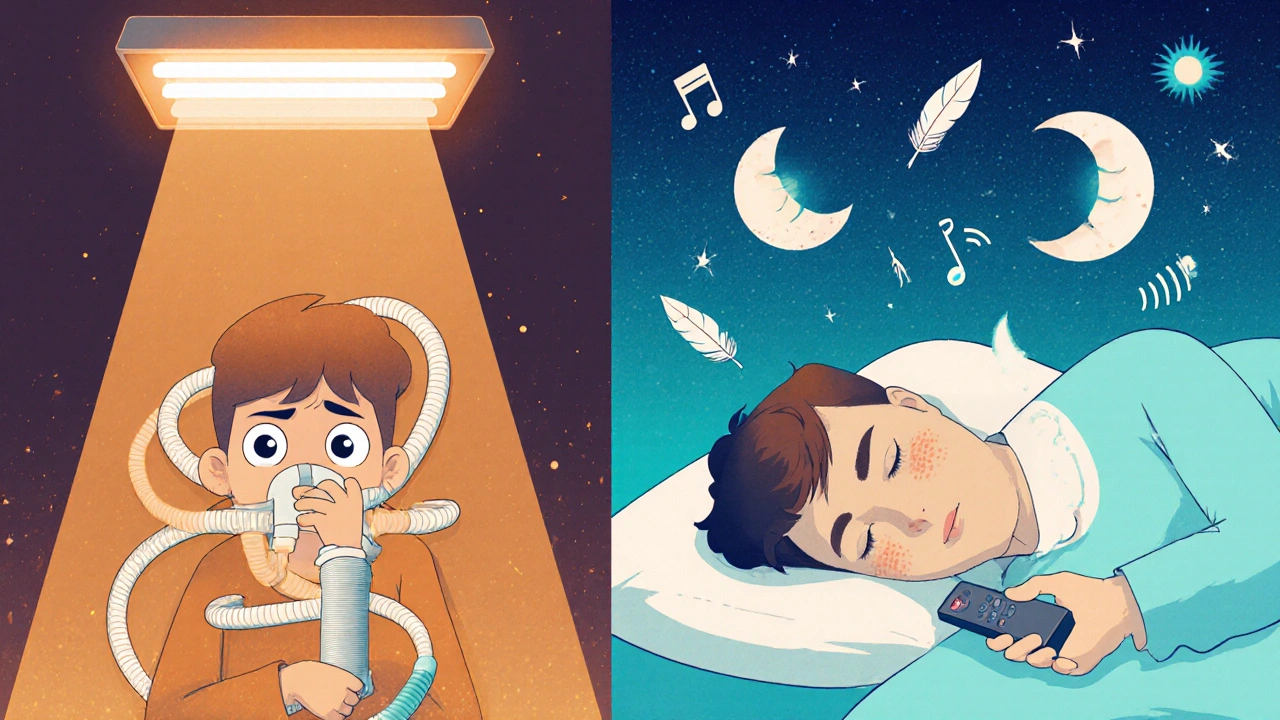If you’ve tried CPAP for sleep apnea and quit because it felt uncomfortable, suffocating, or just plain impossible to sleep with, you’re not alone. Nearly half of people who start CPAP therapy stop using it within the first year. But what if there was another way-something that works while you sleep, without a mask, hose, or machine humming beside your bed? That’s where upper airway stimulation comes in.
What Is Upper Airway Stimulation?
Upper airway stimulation (UAS) is a surgical treatment for obstructive sleep apnea that uses a small implanted device to keep your airway open while you sleep. Unlike CPAP, which pushes air through your nose, UAS gently stimulates the nerve that controls your tongue. When you inhale, the device sends a mild pulse to move your tongue forward, preventing it from collapsing backward and blocking your throat. The most common system used is called Inspire, developed by Inspire Medical Systems. It’s been approved by the FDA since 2014 and is now used in over 200,000 people worldwide. It’s not a cure, but for many, it’s a life-changing alternative to CPAP.How Does the Inspire System Work?
The Inspire device has three parts implanted under your skin:- A small generator (about the size of a pacemaker) placed under your chest
- A stimulation lead connected to the hypoglossal nerve in your neck
- A sensing lead that monitors your breathing pattern
Who Is a Good Candidate?
This isn’t for everyone. You need to meet specific criteria to qualify:- You’re 22 years or older
- You have moderate to severe obstructive sleep apnea (AHI between 15 and 100 events per hour)
- Your BMI is under 35 (some centers accept up to 40)
- You’ve tried and failed CPAP
- You don’t have complete blockage of your soft palate
- Less than 25% of your apneas are central (not caused by airway collapse)
What Happens During Surgery?
The procedure takes about 2 to 3 hours and is done as an outpatient. You go home the same day. Three small incisions are made:- One under your jaw to place the stimulation lead on the nerve
- One lower on your neck to place the breathing sensor
- One below your collarbone to implant the generator

How Effective Is It?
The results speak for themselves. In the main clinical trial (called the STAR trial), patients saw their apnea events drop from an average of 29 per hour to just 9 per hour after one year. That’s a 68% reduction. Two-thirds of patients had at least a 50% improvement. Long-term data shows those results last. Five years later, most people still have the same level of improvement. In one study, 86% of patients said they preferred UAS over CPAP. Eighty percent said they’d recommend it to someone else. Bed partners notice the difference too. At the four-year mark, 85% reported their partner either didn’t snore at all or only snored softly. That’s a huge win for relationships.What Are the Risks and Side Effects?
It’s a surgery, so there are risks-but they’re low. Serious complications happen in less than 0.5% of cases. The most common issues are temporary:- Mild tongue weakness or numbness (affects about 5% of patients, usually fades)
- Sore throat or neck pain for a few days
- Minor infection at the incision site (about 2%)
How Does It Compare to CPAP and Other Surgeries?
CPAP is still the gold standard-but only if you use it. About 30-46% of people quit. UAS doesn’t have that problem. People use it 80-90% of nights, on average. That’s because it’s invisible, silent, and doesn’t interfere with how you sleep. Traditional surgeries like UPPP (removing tissue from the throat) are more invasive, have longer recovery times, and don’t always work. UAS is reversible-you can have it removed if needed. And unlike oral appliances, which only help mild cases, UAS works for moderate to severe sleep apnea.
Cost and Insurance Coverage
The total cost of the procedure, including surgery, device, and follow-up, ranges from $35,000 to $40,000. That sounds steep-but it’s often less than what people spend on CPAP over 10 years: masks, filters, tubing, repairs, and replacement machines add up. Insurance coverage has improved a lot. Medicare covers it for eligible patients. Most private insurers do too-85% of commercially insured people now have access. You’ll need documentation proving you tried and failed CPAP, but your sleep doctor can help with that.What’s Next for This Therapy?
The FDA expanded eligibility in 2023 to include patients with higher BMI (up to 40) and more severe apnea (AHI up to 100). That means more people can qualify now. Researchers are working on smaller devices, longer-lasting batteries, and AI tools to predict who will respond best before surgery. The goal is to make it even more precise and accessible. The market for these devices is growing fast-projected to increase by 14% each year through 2028. That’s because sleep apnea doesn’t go away. And when CPAP fails, people need something that works.Real Stories, Real Results
One man in his 50s, who had used CPAP for five years, said he’d wake up every night feeling like he couldn’t breathe. He stopped using it after his wife complained about the noise. After getting Inspire, he says: “I sleep through the night. My wife says I don’t snore. I feel like I’m 10 years younger.” Another woman, a nurse, said she used to nap at her desk during lunch. After the implant, she started running again. “I didn’t realize how tired I was until I wasn’t tired anymore.” These aren’t outliers. They’re the norm for people who find the right fit.Is It Right for You?
If you’ve given up on CPAP, and you’re still waking up exhausted, snoring loudly, or being told you stop breathing at night, it’s worth exploring. Talk to a sleep specialist who has experience with UAS. Get a full sleep study and airway evaluation. Don’t assume you’re out of options. Upper airway stimulation isn’t magic. It’s not for everyone. But for those who qualify, it’s one of the most effective, least invasive, and most satisfying treatments available today. It doesn’t just treat sleep apnea-it gives you back your sleep, your energy, and your life.Is upper airway stimulation the same as a pacemaker?
It works similarly to a pacemaker in that it’s an implanted device that delivers electrical pulses. But instead of regulating heart rhythm, it stimulates the nerve that controls your tongue to keep your airway open during sleep. The generator is about the same size as a pacemaker and is placed under the chest, but the function and target are completely different.
Can I have an MRI after getting the implant?
Yes, but only under specific conditions. The Inspire device is MRI-conditional, meaning you can have an MRI of your head or neck if the machine is set to certain parameters and the device is turned off beforehand. Full-body MRIs are not allowed. Always inform your radiologist you have an implant before any scan.
How long does the battery last?
The generator’s battery lasts about 11 years on average. When it needs replacing, the procedure is simpler than the original surgery-only the generator is swapped out, not the leads. It’s a shorter procedure, often done under local anesthesia.
Will I feel the device when I’m awake?
No. The device only activates during sleep when you’re breathing in. During the day, it’s completely inactive. Most people report not feeling it at all after the initial healing period. There’s no sensation unless you’re actively using the remote to turn it on or off.
Can I travel with the device?
Absolutely. The remote is small and fits in your pocket. You can take it on planes, use it in hotels, and even use it while camping. Airport security won’t trigger alarms, but you may be asked to show your patient ID card. Keep it handy-it’s provided by the manufacturer and includes device details and emergency contact info.
What if I gain weight after the implant?
Weight gain can reduce the effectiveness of any sleep apnea treatment, including UAS. The device can be adjusted to increase stimulation, but if your BMI goes above 40, the therapy may become less effective. Maintaining a healthy weight helps ensure long-term success.
How soon will I notice results?
Most people start feeling more rested within 2 to 4 weeks after activation. The device is programmed gradually over several visits to find the right level of stimulation. Full benefits usually show up by 3 months. Some report better sleep in the first night, but it takes time for your body to adapt to the new rhythm.
Is this covered by Medicare?
Yes. Medicare covers upper airway stimulation for patients who meet the eligibility criteria, including documented CPAP intolerance and a confirmed diagnosis of moderate to severe obstructive sleep apnea. You’ll still need pre-authorization from your doctor and sleep specialist.







Corra Hathaway
November 20, 2025 AT 18:36Simone Wood
November 20, 2025 AT 22:01Paula Jane Butterfield
November 20, 2025 AT 22:43Sandi Moon
November 22, 2025 AT 07:40Clifford Temple
November 23, 2025 AT 22:55Sheldon Bazinga
November 24, 2025 AT 00:29Daisy L
November 24, 2025 AT 12:06Kartik Singhal
November 25, 2025 AT 03:15Chris Vere
November 25, 2025 AT 21:07Noah Fitzsimmons
November 26, 2025 AT 00:22Anne Nylander
November 26, 2025 AT 05:36Leo Tamisch
November 27, 2025 AT 08:57Eliza Oakes
November 27, 2025 AT 18:17Pravin Manani
November 29, 2025 AT 02:37Mark Kahn
November 30, 2025 AT 17:31